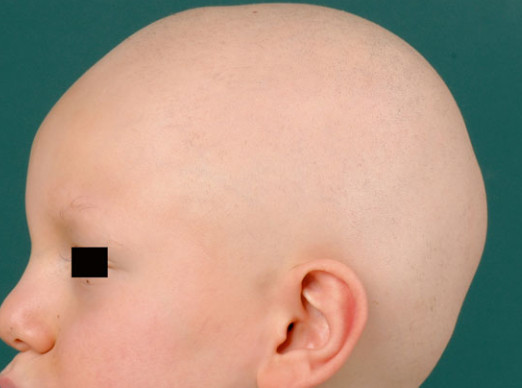Approach to Alopecia areata
History taking
- Onset, course and duration.
- Family and past history of alopecia areata.
- Ask about any other autoimmune diseases e.g. thyroid disease
- Ask about vitiligo, thyroid manifestations, atopic dermatitis, inflammatory bowel disease and psoriasis.
- Ask about manifestations of hyperthyroidism which may include:
- weight loss.
- Increased appetite.
- Heat intolerance.
- Excessive sweating.
- Anxiety.
- Insomnia
- Tachycardia.
- Menstrual changes.
- Bowel habits changes.
- Palpitations.
- Eye changes.
- Ask about manifestations of hypothyroidism
- Fatigue
- Weight gain.
- Cold intolerance.
- Dry skin.
- Hoarseness of voice.
- Constipation.

Alopecia areata
totalis
Clinical examination
Dermatological examination
Confirm the diagnosis and assess the severity according to the following
- Mild cases : three or less alopecia patches with the widest diameter is 3 cm or less.
- Moderate cases : more than 3 patches or a single patch with diameter of more than 3 cm.
- Severe cases: Alopecia totalis or alopecia universalis.
- Ophiasis pattern.
- Ophiasis inversus pattern.
Nail examination
- Pitting.
- Trachyonychia.
- Longitudinal ridging.
- Beau’s lines.
- Onycholysis.
- Punctate leukonychia.
- Red spotted lunulae.
Eye examination
- Exophthalmos.
- Lid lag.
- External ocular movements.
Thyroid examination
- Size changes.
- Pulsation.
- Consistency.
Dermoscopic examination
- Black dots.
- Short vellus hairs.
- Broken hair.
- Exclamation mark hairs.
- Coudability signs.
Lab investigations( to exclude associated autoimmune diseases- no standard list)
- TSH.
- Free T3.
- Free T4.
- Thyroglobulin antibodies.
- Thyroid peroxidase antibodies.
- Antinuclear antibodies (ANA)
- Fasting blood sugar.
Differential diagnosis
Although the diagnosis of alopecia areata is straightforward, The following conditions should be considered
- Tinea capitis.
- Trichotillomania.
- Traction alopecia.
- Secondary syphilis.
- Loose anagen syndrome.
- Temporal triangular alopecia.